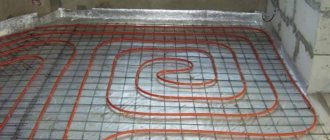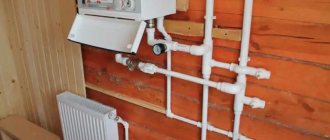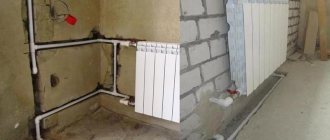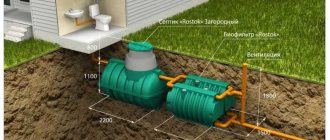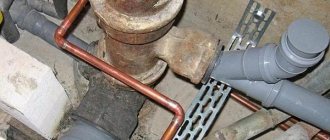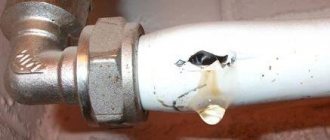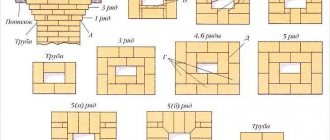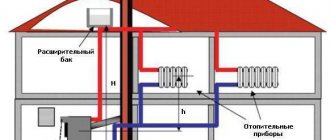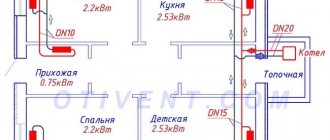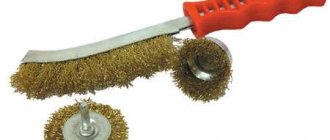Layout of polypropylene pipes
Polypropylene pipes are used for installation of cold or hot water combs and heating.
The choice of diameter in each case is individual - it depends on the volume of liquid that needs to be pumped per unit of time, the required speed of its movement (formula in the photo). Formula for calculating the diameter of polypropylene
Calculating the diameters of pipes for heating systems is a separate topic (the diameter must be determined after each branch), for water supply systems everything is simpler. In apartments and houses, pipes with a diameter of 16 mm to 30 mm are used for these purposes, with the most common ones being 20 mm and 25 mm.
Counting fittings
After determining the diameter, the total length of the pipeline is calculated, and fittings are purchased depending on its structure. With the length of pipes, everything is relatively simple - measure the length, add about 20% for errors and possible defects in the work. A piping diagram is required to determine which fittings are needed. Draw it, indicating all the outlets and devices to which you need to connect.
An example of the layout of polypropylene pipes in the bathroom
To connect to many devices, a transition to metal is required. There are also such polypropylene fittings. They have a brass thread on one side and a regular solder fitting on the other. You should immediately look at the diameter of the pipe of the device being connected and the type of thread that should be on the fitting (internal or external). To avoid mistakes, it is better to write everything down on the diagram - above the outlet where this fitting will be installed.
Next, according to the diagram, the number of “T” and “G” shaped connections is calculated. Tees and angles are purchased for them. There are also crosses, but they are rarely used. By the way, there are corners not only at 90°. There are 45°, 120°. Don't forget about couplings - these are fittings for joining two pieces of pipe. Do not forget that polypropylene pipes are not at all elastic and do not bend, so each turn is made using fittings.
When purchasing materials, agree with the seller about the possibility of replacing or returning some of the fittings. Problems usually do not arise, since even professionals cannot always immediately determine exactly the required assortment. In addition, during the installation process, sometimes it is necessary to change the structure of the pipeline, which means the set of fittings changes.
Compensator for hot water supply and heating made of polypropylene pipes
Polypropylene has a fairly significant coefficient of thermal expansion. If a polypropylene hot water supply or heating system is being installed, it is necessary to make a compensator, with the help of which the lengthening or shortening of the pipeline will be leveled. This can be a factory-made compensator loop, or a compensator assembled according to the diagram from fins and pieces of pipes (pictured above).
Laying methods
There are two ways to install polypropylene pipes - open (along the wall) and closed - in grooves in the wall or in a screed. Along the wall or in the groove, polypropylene pipes are attached to clip holders. There are single ones - for laying one pipe, there are double ones - when two branches run parallel. They are attached at a distance of 50-70 cm. The pipe is simply inserted into the clip and held in place thanks to the elastic force.
Fastening polypropylene pipes to walls
When laying in a screed, if it is a warm floor, the pipes are attached to the reinforcing mesh; no other additional fastening is required. If the lines to the radiators will be sealed in, the pipes do not need to be fastened. They are rigid and do not change their position even when filled with coolant.
Option for hidden and external wiring in one pipeline (the wiring behind the bathroom was made open - less work)
Soldering nuances
The process of welding polypropylene pipes itself, as you have seen, does not leave much work, but there are a lot of subtleties. For example, it is not clear how to adjust sections when joining pipes so that the pipes are exactly the length required.
Another aspect of welding polypropylene pipes is soldering in hard-to-reach places. It is not always possible to fit a pipe and fitting onto a soldering iron on both sides. For example, we solder in the corner. The soldering iron has to be shoved into a corner, on one side the nozzle rests directly on the wall, you can’t pull the fitting onto it. In this case, install a second set of nozzles of the same diameter and heat the fitting on it.
How to solder polypropylene pipes in hard-to-reach places
How to switch from iron pipe to polypropylene.
Types of polypropylene pipes for heat supply
Marking of polypropylene pipes
Professional installation of polypropylene heating begins with the selection of pipes. They differ not only in diameter and wall thickness, but also in other technical qualities.
Truly high-quality heating of a private house made of polypropylene with your own hands is only possible when using appropriate pipes. Almost all information about their properties can be found from the markings applied to the outer surface. Some of the points do not need decoding. But special attention should be paid to the following parameters:
- Material of manufacture . For heating pipes, polypropylene grade PP-R is used. It is heat resistant. In addition to it, you can find pipes of the PPH and PPB brands. With their help, you can organize a cold water supply system;
- Nominal working pressure . Indicated by the symbols PN-10 (16,20 or 25). For autonomous heat supply, you can install glass fiber reinforced polypropylene for heating PN-20. In centralized systems, it is recommended to install PN-25 pipelines due to possible pressure surges;
- Range of diameters, wall thicknesses and maximum permissible temperature exposure . Data can be taken from the table below.
| Pipe brand | Diameter range, mm | Wall thickness, mm | Maximum water temperature, °C |
| PN-10 | 20-110 | 1,9-10 | +20 |
| PN-16 | 16-110 | 2,3-15,1 | +45 |
| PN-20 | 16-110 | 2,6-16,1 | +60 |
| PN-25 | 21,2-77,9 | 2,8-18,3 | +80 |
Pipe delamination
All polypropylene pipes for heating must have a reinforcing layer. It is made from aluminum foil or fiberglass. The latter are characterized by higher reliability, but also higher price. If the technology for applying aluminum foil is violated, the outer or inner layer may separate from its surface.
This phenomenon is quite common for handicraft products. Therefore, it is preferable to purchase reinforced polypropylene for heating using fiberglass.
There is color coding for polymer products. Glass fiber reinforced polypropylene for heating will have a red longitudinal stripe on the surface, indicating the possibility of use in heating.
Tying methods
The solid fuel boiler is the main element of the heating system. To ensure timely supply of thermal energy to heated rooms, the boiler requires appropriate piping.
It consists of the following elements and devices:
- a set of pipes for supplying coolant and removing combustion products;
- heating devices - radiators, heated floors, heated towel rails;
- shut-off valves;
- measuring and control instruments.
In each specific case, the correct piping is required, which can ensure long-term and trouble-free operation of the heating system.
The choice of the optimal piping for a solid fuel boiler is determined by elementary everyday considerations.
Scheme:
First of all, you need to take into account the characteristics of the local climate and the volume of heated premises.
If residents spend only weekends in a country house, then it is advisable to choose a scheme with a buffer capacity.
When people live in the house permanently, you can get by with a circulator harness. natural type. In any case, it is preferable to purchase a long-burning solid fuel boiler.
Practice shows that consumers increasingly prefer models with automatic fuel supply.
Natural circulation scheme
Piping a solid fuel boiler with circulation. The natural type can be called the simplest.
You can install and start up the heating system yourself, without involving third-party specialists.
The system is not equipped with a pump, since the coolant moves through the pipes thanks to the elementary laws of physics.
During installation and piping, it is necessary to install the solid fuel boiler below the level at which the heating radiators are fixed.
The pipe that serves as the main line for moving hot water must have a diameter of at least 30 mm.
In order not to disrupt the circulation. coolant, the pipes must have a slope along the direction of travel of at least 5 mm per linear meter.
This heating system is as simple as it is reliable, but requires constant supervision and control.
Forced circulation circuit
The method of piping a solid fuel boiler with a circulation. forced type is considered optimal in terms of price-quality parameters.
Among other advantages, it is necessary to note the ability to regulate the temperature of each heating device. This need arises in the spring, when it is already warm outside during the day and gets cold again in the evening.
Video:
To maintain stable heat supply to the premises, the system is equipped with an expansion tank. The presence of this element helps slow down the corrosion process of metal parts.
In recent years, lining solid fuel boilers with polypropylene has become widespread.
The reliability and manufacturability of polypropylene products has been proven by many years of practice.
As for the installation of pipelines made of this material, it is carried out according to traditional rules, only soldering is used instead of welding.
Polypropylene pipes are successfully used in systems with a buffer tank and other, simpler ones.
Collector circuit
For a long-burning solid fuel boiler, the manifold-type piping is considered the most costly and difficult to install.
At the same time, it allows you to achieve maximum energy savings during operation of the heating system.
By its design, the manifold in the piping of a solid fuel boiler with a buffer tank is the most complex unit.
Measuring instruments, taps, valves and other necessary elements are mounted on the manifold. This layout of the heating system greatly facilitates its management, supervision and maintenance.
The initial investment in the purchase of instruments and equipment pays off in the shortest possible time.
Video:
Solid fuel boilers are most often used to create a heating system in buildings that are located considerable distances from industrial centers.
Often in such places there are no stationary sources of electricity. When piping the boiler under such conditions, it is possible to provide a backup operating system. This will require a small addition to the standard strapping scheme.
When starting to piping a long-burning solid fuel boiler, you need to be aware that this is a responsible process.
If the owner of the cottage has a desire to do all the work with his own hands, then it is necessary to properly prepare for the process.
Practice shows that to obtain a decent result, it is preferable to entrust the installation of the boiler to professionals.
Polypropylene pipes are new opportunities
Products made from PPR have optimal technical characteristics. They open up new opportunities for owners of suburban housing, where the heating system is powered by boilers. Their use reduces the complexity of installation. This option is not only economically beneficial, but also reliable.
Each person understands the word comfort in his own way, but everyone needs warmth.
You can provide them to your home without large capital and time expenditures by using polypropylene pipes, and awareness of heating issues will allow you to make the right decision. Source
Advantages of heating circuits made of polypropylene
The use of polypropylene pipes in heating is due to many advantages, among which the following can be noted:
the service life of polypropylene heating pipes ranges from 25 to 50 years; due to the special composition, the internal walls of such pipes are not subject to corrosion; even at high temperatures, polypropylene withstands chemical influences; the coolant in the heating circuit made of polypropylene does not make unpleasant noise; the reliability of the joints of these elements allows you to equip a reliable and integral structure; When performing a procedure such as soldering heating with polypropylene pipes, you will not need to use complex construction equipment, since it will only be enough to use a standard welding machine or soldering iron; the cost of polypropylene pipes is affordable for the average consumer; due to the special properties of such a material, it does not allow oxygen to pass through itself, which helps protect the system from the formation of rust in it and from damage to metal parts; the strength of polypropylene pipes is very high; An equally important property of these products is their environmental friendliness and harmlessness to residents.
Photos to the text
Connection of polypropylene pipes with metal-plastic pipes
Scheme for accounting for temperature deformation of pipes
Soldering technology for polypropylene pipes
Shaver for stripping polypropylene pipes with external reinforcement
Additional material: Heating boiler piping
There are two options for boilers - floor-mounted and wall-mounted. Connecting them has its own characteristics. The piping scheme common to all types of boilers includes:
- boiler;
- radiator;
- ball valves;
- nuts fixing the boiler;
- cleaning filters;
- thermal heads for batteries;
- tees, corners;
- Mayevsky cranes;
- different valves;
- measuring instruments;
- circulation pump;
- distributors;
- fastener
https://youtube.com/watch?v=BlGNuAQyGvE
The piping scheme in the case of a wall-mounted boiler can be exclusively closed, since these boilers are autonomous. A floor-standing boiler cannot be placed at the top of the wiring, since it does not exhaust air. As a result, air pockets will appear. Most wall-mounted boilers have air vents, so they independently release air masses.
When piping a gas boiler with a polypropylene circuit, a large number of connections should not be allowed. The main condition is the presence of a rigid joint at the point where the gas is supplied to the unit. A feature of a solid fuel boiler is the lack of a heat supply control function. When forced circulation is turned off, pressure will increase and the system may fail.
For such cases, there are emergency schemes. One of them is installing an automatic bypass. When the pump is running, the coolant flows through it, and the bypass is closed. When the pump stops, the fluid flow is redirected and passes through the bypass. For heating circuits installed in a private house made of polypropylene with a circulation pump, the feasibility of use and parameters of the latter are determined by hydraulic engineering calculations.
Types and types of connection fittings
The English word "fit" means to gather. It is thanks to him that the fitting got its name. With the help of such connecting elements, pipes are joined in the same and different planes.
They allow you to create branched systems and avoid obstacles. When using fittings, pipes of the same or different diameters are joined.
Manufacturers produce threaded and soldered connecting elements. The first type allows you to connect polypropylene communications with steel pipes and fittings in the form of taps and valves.
The second type is intended for connecting polymer elements to each other by soldering. First of all, when using special welding equipment. It heats the parts, so their structure softens. Only after this the fitting can be put on the pipe.
Couplings and adapters
The simplest fitting for polypropylene pipes is a coupling. It is made in the form of a barrel, the internal diameter of which corresponds to the cross-sectional size of the pipe along the outer edge.
PP coupling
The couplings have thicker walls. They are used to connect pipes of the same diameter, inserted into the so-called barrel on both sides if it is made entirely of polypropylene. When the coupling is threaded, soldering is performed on one edge only.
Combined coupling PP
An adapter is an element that allows you to connect pipes of different diameters. Used in branched systems with several consumers.
Adapter PP
Using adapters, it is possible to narrow the diameter of the communication and create excess pressure in the circuit.
Angle, tee and cross
In most cases, utility lines have a branched structure. Angles are used to rotate the system 90° and 45°. They form a system of the required configuration. After all, polypropylene is a hard and elastic material that bends only after heating.
However, this method is not used when laying communications. As a result, when bending, the cross-sectional size and wall thickness of the pipes change. This reduces the strength characteristics of the system. Consequently, it often leads to the appearance of a leak when the pressure and temperature of the moving medium increases.
Corner pp
Angles are also available with a 3/4 female thread on one end. They are used during installation of mixers.
Tee pp
Tees and crosses are used to branch utility lines. They allow you to connect two or three taps together. The sizes of fittings for polyethylene pipes are selected depending on the design.
Crosspiece pp
Tees and crosses allow you to create bends at right or acute angles. This type of fitting is also available with threads on one end. In this case, they are used when installing shut-off valves.
Bypass and compensators
Bypasses are used to bypass obstacles on the way of laying systems. With their help, a more round bend is created than when using corners. Contours allow you to smoothly change the direction of pipelines. Therefore, it is possible to lay communications that have a more attractive and neat appearance.
PP bypass
Compensators are parts of engineering systems that can “absorb” pressure and temperature changes in hot water supply and heating pipelines. They increase reliability and maintain the integrity of networks. Several ready-made solutions are available. Polypropylene expansion joints are made in the form of a loop.
American fitting
The installation process of PP systems is made easier by the American. This is an element made of metal and plastic with a rubber insert. The parts are used for detachable sealed connections.
American pp
Such fittings with internal or external threads on one side are used when installing shut-off valves, hydraulic accumulators, circulation pumps, heating radiators, and so on.
Taps, valves and plugs
During the operation of utilities, it is often necessary to shut off the water. This is achieved by installing taps and valves. They can be made of polypropylene or brass.
In the first case, parts are soldered into systems. In the second, adapters are additionally used. Consequently, they allow threaded connections of network parts made of different materials.
Crane pp
Plugs are used in places where polypropylene pipelines end.
Plug PP
Such parts can be soldered to permanently block the outlet or temporarily installed using a threaded connection.
Polypropylene pipes with fiberglass
PPR pipes are divided into pipes for cold and hot water supply (heating is also included). Previously, PPR heating pipes were reinforced with special aluminum foil. This led to an increase in the price of the finished product. Over time, fiberglass pipes appeared, which replaced similar pipes with aluminum.
Few people know, but when heating your home with polypropylene pipes with fiberglass, you are at risk. Fiberglass tends to break down. Sometimes just throwing a pipe on the floor is enough to damage the reinforcing layer.
It is also impossible to work with such a pipe at low temperatures, since the fiberglass becomes brittle and is subject to rapid fracture. And it performs not only the function of reinforcement, but also an oxygen barrier.
Just as we know, such pipes are stored in ordinary warehouses and no one there monitors the microclimate required for storing pipes.
Therefore, everything is simple here. Fiberglass is good, but you have to be careful with it.
PPR connection without welding
There are situations in life when the use of traditional soldering of polypropylene parts is excluded. For example, the joint is located in a hard-to-reach recess, or during installation the power suddenly turned off, and you only have to weld the last connection. There are 3 one-time methods:
- heating with a gas burner and subsequent docking;
- use of Gebo type compression coupling;
- planting elements on anaerobic glue.
Why are these options considered one-time use? Gluing and heating with a torch cannot provide the required reliability of the joint and are used only as a last resort on cold water supply lines. It is highly undesirable to connect heating and hot water pipes in this way. Gebo couplings are reliable, but too expensive.
The connection technology without a soldering iron is simple - the parts are degreased, gently heated with a burner flame, joined and fixed for 6-10 seconds. The technique is demonstrated in the video below.
Bonding is carried out according to the instructions on the packaging of the anaerobic sealant. The end of the pipe and the fitting socket should be cleaned, degreased and glue applied with a small brush. The elements are then fastened together using compression.
Common questions and answers about soldering polypropylene
Is it possible to solder pipes from one manufacturer and fittings from another?
Of course it is possible, but I would like to warn you that both couplings and pipes should be used of proper quality. You should not use parts from unnamed manufacturers. In unprofessional stores they often sell pipes from different companies, but the fittings are the same, from an unnamed manufacturer. I don't recommend using this combination. In general, nothing prevents you from soldering pipes and fittings from different manufacturers, with or without different reinforcement on different sides of the coupling.
Is it possible to bend polypropylene pipes?
They cannot be bent, either during installation or after. If there is a need to bend the pipe during installation, then you should use contours or combinations of corners. To be fair, it is worth noting that the weak point of the bending pipeline is the junction of the pipe and the fitting. This mating point breaks off at some breaking force. To make sure of this, just solder a test structure from a corner and two 50 cm pipe sections, and try to break this “poker” with your hands.
Sometimes there is a need to solder a node with a non-standard angle. Let me remind you that PP corners come in only two types: 90 and 45 degrees, at least I haven’t come across any others. What to do if you need to turn the pipe to a different degree? There are two methods known to me:
Using two 45° corners, you can make any angle by changing the angle of rotation of the corners relative to each other. The disadvantage of this method is that due to the non-standard rotation, the connection will not be in the same plane.
The second way is to disrupt the alignment of the pipe and fitting at several connections. Do not forget that the straightness at the junction of the pipe and fitting should not deviate by more than 5°.
How to solder pipes if the faucet does not hold it?
It is strictly forbidden to weld if there is water in the area to be soldered. If for some reason it is not possible to completely shut off the water, you need to stop it while welding. On the Internet they advise plugging the pipe with bread crumbs, but the problem is that the crumb is immediately squeezed out by the newly created pressure in the pipe. Therefore, the method will only work when it is possible to open the area up to the soldering point for air to escape. And when the pipes are soldered, the crumb easily pops out when pressure is applied.
Advice: if during welding you could hear the hissing of water on the nozzle, it is better to cut out the assembly and redo it! It’s better to spend extra time during installation than to fix and eliminate leaks in the future, with a bunch of problems that pop up!
In this photo you can see that the plug on the filter is unscrewed and excess water flows down the cloth from there. And in the place of soldering the bread crumb is plugged. Thanks to the open filter, we had a little over a minute to do the soldering before the water squeezed out the crumb.
Actually, this is where I propose to end the presentation of information. Over time, I plan to expand the list of common questions about soldering polypropylene pipes.
Rate this publication:
- Currently 3.95
Rating: 3.9 (19 votes)
Selection of PP heating pipes
Heating systems are created from polypropylene pipes with reinforcement and a layer of anti-diffusion material that blocks the access of oxygen
Therefore, you need to pay attention to the labeling
PP pipes
If it is necessary to connect a polymer heating circuit to a solid fuel boiler. First, a section at the supply and return with a length of at least 1.5 m made of steel or copper is installed.
How to choose the diameter
Accurate selection of sections and lengths of individual sections of the pipeline system is carried out using hydraulic calculations. If the area of the house does not exceed 250 m², the computational process need not be carried out.
The diameter is selected based on the required total battery power. In this case, the cross-sections of the main pipes and risers will be larger compared to the same dimensions of the inlet and outlet sections near each radiator.
Hydraulic calculation allows you to determine:
- required coolant volume;
- pressure loss in the entire pipeline system and in areas from the boiler or pumping unit to each battery.
To determine the flow rate of heated water, the heat losses of the house are divided by the product of the heat capacity of the coolant and the difference between its temperatures at the outlet and inlet of the heat-generating installation
The speed of water movement is calculated by the ratio of its flow rate in a certain area to the cross-sectional area of the pipeline.
Pressure loss is calculated by multiplying the length of a pipe with the same diameter and the specific friction loss. The last value is taken from reference literature or obtained from the manufacturer.
Resistance losses are calculated for fittings, fittings and equipment. The required value is determined by the product of the density of the coolant, its speed squared, which is divided by two, and a special coefficient indicated by the manufacturing company.
All obtained resistance values are summed up. The result is compared with control values. Error-free hydraulic calculations can be performed by qualified specialists.
Types of plastic pipes for heating
Currently, manufacturers offer several types of plastic pipes for autonomous heat supply. The difference between them lies in the materials used, which ultimately determine their properties. Therefore, before making plastic heating with your own hands, it is necessary to familiarize yourself with the characteristics of the pipes.
Metal-plastic pipes for heating
The types of plastic pipes used for heating can be divided into three types - metal-plastic, polypropylene and cross-linked polyethylene products. Each of these types has unique performance properties. The choice is determined by the initial heating characteristics - pressure, possible temperature changes, intensity of operation, etc. Therefore, to produce high-quality plastic heating in a private home, we will consider the most significant parameters:
- Temperature operating conditions . Pipes made of cross-linked polyethylene have the least rigidity retention - deformation begins already at +80°C. Reinforced models of polypropylene products have a higher temperature threshold - up to +90°C. Metal-plastic pipes are characterized by the best performance – up to +95°C;
- Connection reliability . Water heating made from metal-plastic pipes has a lower reliability indicator. Clamp connections are susceptible to depressurization due to sudden pressure surges. Pipes made of cross-linked polyethylene have the same negative properties. For autonomous or centralized plastic heating with your own hands, it is recommended to use polypropylene pipes, which are connected by soldering;
- Durability . If operating standards are observed, the repair-free operation time of plastic heating wiring can be 20-25 years. However, this indicator directly depends on the heating characteristics and many external factors.
Experts advise choosing plastic heating pipes made of polypropylene. They have optimal cost, reliability and can be installed independently.
Polypropylene pipes for heating
The determining indicators when choosing this type of pipeline are the diameter of the product and the type of reinforcement. To maintain the rigidity of the plastic shell when exposed to high temperatures, the following materials can be used in the manufacture of reinforced plastic pipes for heating:
- Foil-coated aluminum . The disadvantage of this type of reinforcement is the likelihood of plastic peeling off from the reinforcing layer. This occurs when pipe manufacturing technology is not followed;
- Fiberglass . A relatively new material that is characterized by a high degree of reliability. The only drawback of fiberglass-reinforced plastic heating pipes is their high cost.
Considering the large number of types of plastic pipes for heating, both by material and by brand, when choosing, you need to pay attention to their appearance and markings. Knowledge of the latter will allow you to correctly determine the type of plastic pipes for a specific heating system.
For a water heated floor system, it is best to use cross-linked polyethylene pipes. They have sufficient flexibility, which is a big “plus” when forming a warm surface. To install this type of plastic heating with your own hands, you should choose pipes with a protective layer that prevents oxygen from entering the coolant.
Step-by-step instructions for welding PP pipes
After purchasing all the necessary pipes and fittings, you can begin welding them. This process will be discussed step by step, with illustrations, so that no questions remain.
Step #1 – cutting the pipes
This process is carried out using a pipe cutter. If the cut is beveled, then the longer edge can form a bead during soldering and narrow the internal passage of the fitting.
The pipe cutter has a wide base, which helps maintain a right angle when cutting, but this does not mean that you do not need to control the perpendicularity of the cut yourself
Pipe cutters have a maximum diameter limitation, so you need to choose the model that fits the purchased pipes.
Step #2 - pipe processing and chamfer formation
After trimming, it is necessary to form a small chamfer on the part that will fit into the socket. For this purpose, hand calibrators or screwdriver attachments of various sizes are used.
Both tools have built-in knives that form a chamfer with standard parameters.
You can form a chamfer using a screwdriver attachment directly in your hands, without resorting to rigidly fixing the pipe in a vice.
To obtain a cut, you need to place the pipe on a hand calibrator and rotate it around the axis several times with pressure.
On reinforced pipes, in addition to chamfering, the top layer of PP and aluminum foil is removed using a shaver. It looks like a cylinder with handles and fits only one specific size.
It is not recommended to remove layers of reinforced pipes with a regular knife - this can damage the surface to be soldered and reduce the strength of the connection.
After chamfering and removing the aluminum foil, you need to wipe all parts clean.
Step #3 – preparing the soldering iron
The soldering temperature for polypropylene pipes varies from 260 to 280 °C, but amateurs are better off using non-adjustable soldering irons or heating up to 260 °C. We recommend taking a closer look at the soldering temperatures of polypropylene.
Before turning on, you need to put double-sided attachments (mandrel and sleeve) on the soldering iron and place the device on a cross-shaped stand.
The more powerful the soldering iron, the greater the number of pipes it can weld per unit of time, but for home work an 800-watt device is sufficient
Then you should turn on the soldering iron. When it reaches a temperature of 260 °C, the green signal light will light up.
Step #4 - heating and joining parts
It is recommended to wear gloves when working with pipes. To heat the parts, it is necessary to simultaneously place one part to be connected onto the mandrel and insert the second into the sleeve.
It is necessary to connect and disconnect polypropylene parts with a soldering iron directly without twisting movements. A similar rule applies when connecting heated products.
To maintain the depth of the connection, you can make a corresponding mark on the pipe with a marker in advance and focus on it when inserting the product into the socket.
The table below shows the standard heating, connecting and cooling times for pipes, depending on their diameter, as well as the depth of insertion into the socket. When working in a cold room, the heating time can be increased by 1-2 seconds.
The time parameters indicated in the table are approximate. For exact numbers, please refer to the instructions for the specific soldering iron model.
After heating, the parts to be joined must be joined together with direct movement to the intended line.
It is important not to allow parts to rotate
Shifts of the pipe and fitting relative to each other are allowed only for 4-12 seconds. After this, any progress will have a very negative impact on the quality of the connection.
After joining, it is necessary to allow the polypropylene to cool for the time indicated in the table. It is advisable to look at the resulting internal seam to make sure that the overlap does not block the passage. Otherwise you will have to resolder the parts. This completes the soldering process.
In order to avoid popular mistakes in the process of welding plastic, we recommend that you familiarize yourself with the rules and mistakes of soldering.
Security measures
When working with a heating device, it is necessary to observe personal protective measures:
- The soldering iron must be installed on a horizontal surface in a place free from materials.
- The technician must wear protective gloves (for working with hot tools) and comfortable overalls.
- Avoid bending over melting plastic as this process releases harmful fumes.
- The room should be relatively clean. The working surface is free from dust and debris.
- The connection between the soldering iron plug and the network must be tight and the cord must be loose.
We recommend that you read: Advantages and disadvantages of a galvanized steel drainpipe
The welding tool is preheated for 20 minutes if it does not have a corresponding indicator.
Which polypropylene pipe layout for your home should you choose?
The heating scheme of a house is chosen depending on its volume and number of floors. An ordinary one-story house is heated using natural circulation. The batteries are placed along the walls and connected to the heating unit. For buildings with 2-3 floors of large area, coolant is supplied under pressure.
Wiring with natural circulation
In a single-pipe arrangement with natural circulation, an expansion tank located in the attic is used; fluid movement is carried out according to the law of gravity. the batteries are connected in series. As the coolant passes through, it cools down. The last battery receives cooled liquid.
This model does not provide uniform heating of the room. Used in single-story and small private houses.
